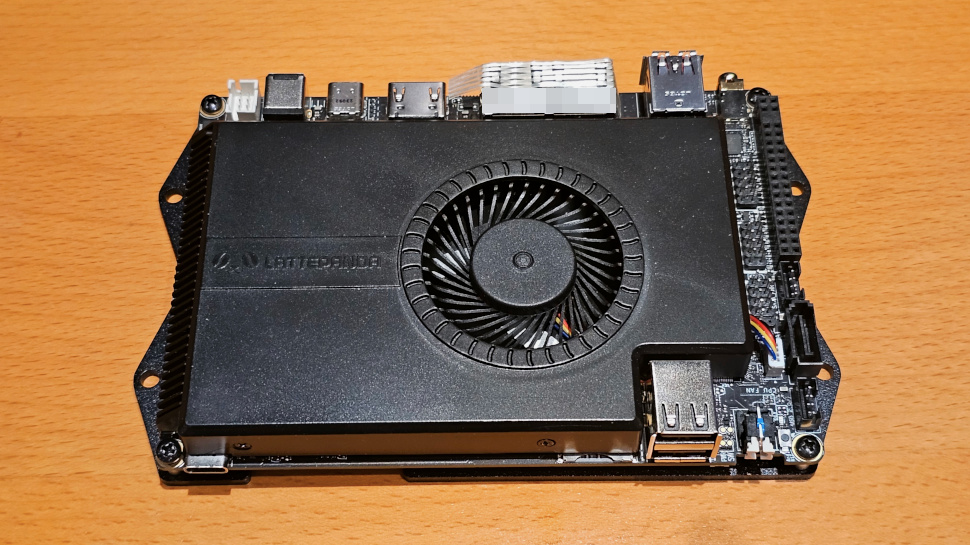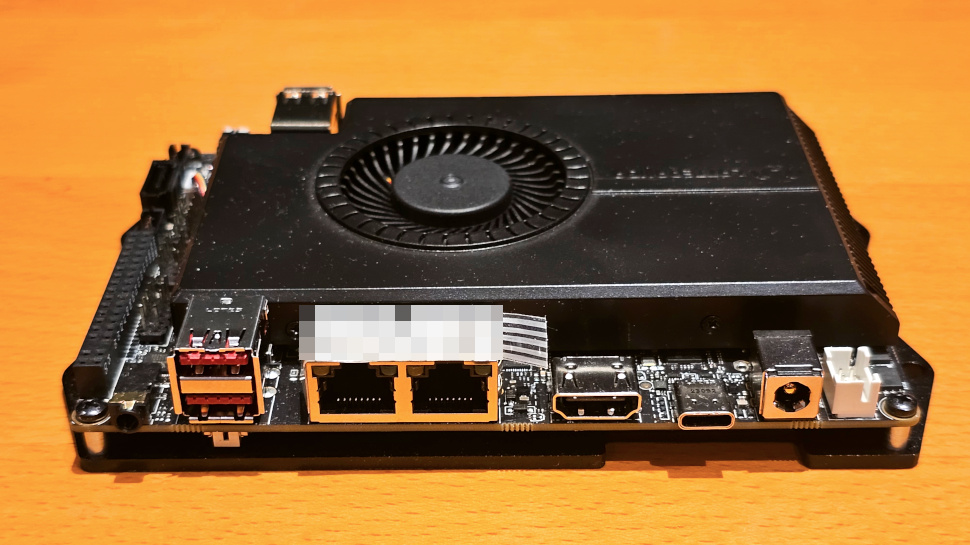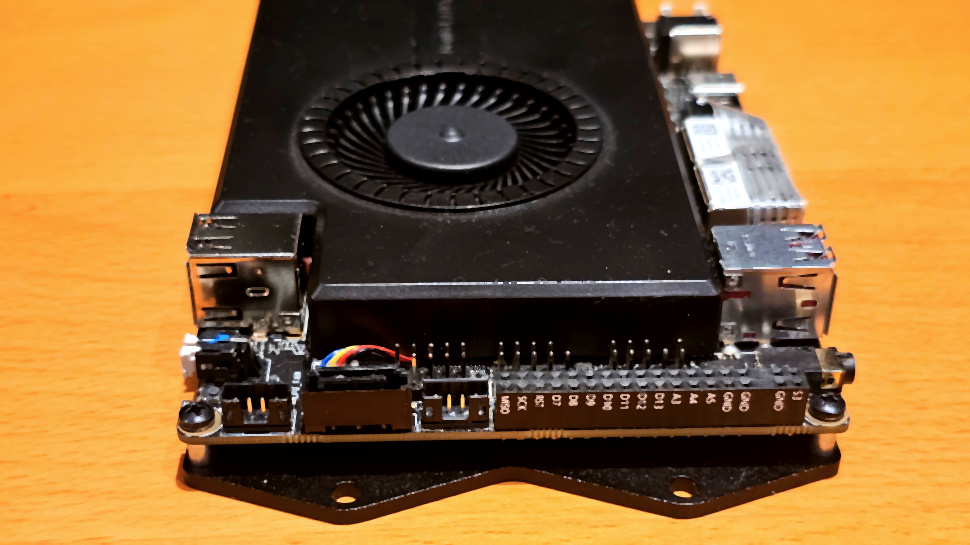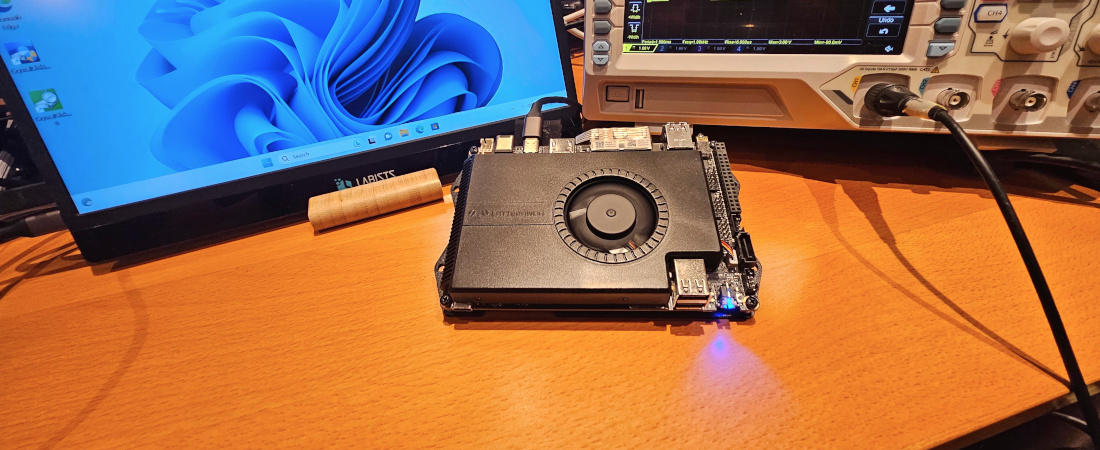TechRadar Verdict
LattePanda’s Sigma is an excellent addition to any hobbyist bench. With a powerful 12 cores Intel CPU, its extreme versatility allows it to be used for office work during the day while turning into an exciting gaming platform at night, with only its high-cost preventing mass adoption.
Pros
- +
12 cores, 4.6GHz CPU
- +
WiFi 6E
- +
Thunderbolt 4
- +
Integrated Arduino platform
Cons
- -
Expensive
Why you can trust TechRadar
CPU: i5-1340P
GPI: Intel Iris Xe G7 80EU
RAM: 16GB LPDDR5-6400
Storage: SN770 500GB NVMe PCIe4, 1 x M.2 NVMe, 1 x SATA, III, 1 x M.2 SATA III
Expansion: 23 General Purpose 5V I/Os
Display: 1 x HDMI 2.1, 1 x eDP 1.4a, 2 x DP 1.4b (TB4)
Networking: 2 x 2.5GbE, 1 x WiFi6e, Bluetooth 5
Ports: 2 x TB4, 2 x USB3.2, 2 x USB2.0, 1 x HDMI, 1 x 3.5mm audio, 1 x SATA3
Weight: 438g
Dimensions: 10.2cm x 14.6cm x 2.7cm
Power Consumption: 7W nominal, headless
The LattePanda Sigma is one of the most powerful single-board computers money can buy right now. Equipped with a state-of-the-art 13th Gen Intel CPU, 16GB LPDDR5 of RAM, 500GB NVMe storage, two 2.5Gb Ethernet ports, and LattePanda’s low-speed connector, this offering is not only ideal for interfacing with Arduino-compatible modules but also in systems requiring heavy CPU processing.
The PCB is twice as big as a Raspberry Pi 4 but should offer more than four times the computing power. The Sigma shines by providing copious amounts of storage and display ports. It is perfect for a high-end multimedia station supporting transcoding or as a high-performance gaming emulation platform. LattePanda has included a WiFi 6E module which gives twice the throughput of a 1Gb Ethernet connection. The Sigma platform should stay relevant for the next decade.
LattePanda has many similar single-board computers in stock, ranging from its lowly first generation built around a Z8350 CPU to the mighty Sigma. The least expensive board has an MSRP of $105, while a full-fledge Sigma costs $648. This is the embedded board to get if you need a speedy CPU with plenty of high-speed interfaces, storage, and a 32-bit microcontroller.

LattePanda Sigma: Design
The LattePanda Sigma ships in a sturdy cardboard box which perfectly shields the board’s components during shipping. Accessories include a 19V 90.1W universal power adapter with international power cords, a small hardware bag containing spare screws and spacers, two flexible WiFi antennas, and a spare heat pad to place on a second NVMe SSD. The embedded board measures 10.2cm x 14.6cm x 2.7cm for 438g. An active heatsink and a metal backplate that doubles as an SSD heatsink enclose the PCB entirely except for connectors.
Powering the Sigma can be done in several ways. The most convenient is through the Thunderbolt 4 port with the help of a docking station and a power supply capable of at least 100W. The JST PH 2.0 8-pin connector next to the DC jack allows integration into systems that supply their own 12V power.
The Sigma uses a 13th-generation Intel Core i5-1340P CPU powered by 12 cores. The processor can boost its frequency up to 4.6GHz, yielding performance similar to desktop PCs while consuming a fraction of energy. The built-in graphic unit sports an Intel Iris Xe accelerator and gives acceptable gaming framerates. The dual-channel soldered 16GB LPDDR5 memory has a bandwidth of 102GB/s, and two NVMe M.2 slots support PCIe Gen 4 and Gen 3. Peripherals connected through two USB 2.0 Type-A, two USB 3.2 Type-A, and two Thunderbolt 4 Type-C provides 100GB/s of bandwidth.
Thanks to a high-performance processor, the Sigma is more than adequate for office applications or watching 4K videos. It is an excellent embedded development platform, the onboard ATmega32U4 8-bit microcontroller giving direct access to thousands of Arduino libraries and projects through 23 5V-compatible input/output ports. The SBC has an RS232/485 port and a DC barrel socket supporting 12V to 20V.

LattePanda Sigma: In Use
The Sigma comes to life by pressing the side push button. The system, which can also turn on automatically when power is applied, takes less than thirty seconds to boot Windows 11 from the NVMe storage. A silent fan cools the 28W CPU while the bottom metal plate, which holds the motherboard, doubles as a heat dissipator for SSDs.
The user can readily jump into developing embedded projects thanks to a preinstalled IDE that supports the onboard Arduino Leonardo. The microcontroller connects to the main CPU through a dedicated serial port, which acts as a programming and debugging port. A large connector brings various microcontroller pins to the external world. Labels for each pin are printed on the side, making troubleshooting a stubborn circuit a breeze.
One application that suits the mini-computer well is a gaming emulator. This is precisely what the MAME open-source project does. The onboard Arduino microcontroller interfaces joypads and other gaming accessories to the MAME application, thus drastically reducing the number of external parts needed. The Intel CPU can easily emulate 64-bit platforms like the N64 close to full speed.
Evaluating the raw performance of the CPU consists of running Geekbench6 for Windows. The benchmark’s engine runs applications similar to those found in an office setting. The Sigma earns a score of 2259 in single-core application and 9293 in multi-core. The stock WD Black SN770 NVMe storage yields about 3.4GB/s and 3.6GB/s for write and read operations, respectively, using CrystalDiskMark.

LattePanda Sigma: The competition
Single-board computers that are both affordable and powerful are rare. Using an x86 CPU like the i5-1340P found in the Sigma opens the door to popular and well-supported applications and software libraries. Users can get answers to issues right away on web forums, while support for drivers is far better than on other platforms. The drawbacks are higher energy consumption and a hefty price tag.
For a fraction of the price of the Sigma, the Odroid H3+ has an Intel Pentium Silver N6005 processor. This Quad-core chip is no match for the Core CPU found on the Sigma, scoring an index of 600 on Geekbench 6, compared to 1800 for the i5-1340P. The H3+ comes without memory and storage, giving an underwhelming out-of-box experience compared to the Sigma. Finally, there is no Arduino co-processor on the H3+, which makes interfacing with embedded modules more complicated.
LattePanda Sigma: Final verdict
The LattePanda Sigma brings a CPU that packs 12 powerful cores in a package slightly bigger than two decks of cards. With interfaces such as Thunderbolt 4, NVMe, 2.5GbE, and WiFi 6e, the Sigma immediately turns into a platform that oozes performance and versatility. The active fan does an excellent job cooling the slim heatsink while entirely silent. A metal backplate serves as a heatsink for the NVMe storage. One of the main selling points is the built-in Arduino sub-system, which is, without a doubt, very easy to use.
Even though the board is compact, it could have been a tad smaller. The lack of enclosure to protect sensitive electronics is also a letdown. Using a memory-down approach for the DDR5 has benefits, such as lowering costs, but it ultimately prevents memory upgrades compared to having SODIMM sockets.
Buy if
You want performance in a small package and an embedded controller, all this consuming as little as possible.
You want to have plenty of ports, storage, and screens.
Don’t buy if
You need a single-board computer but are on a budget.
Low power is of utmost importance.
My interest has been piqued by everything electronic since a young age, with a penchant for the dark art of tearing things apart. My daily duty is to marry software and hardware modules and I have to admit that this is much harder than cooking. When I’m not busy at work, I’m on the lookout for the latest and greatest hack! I am passionate about portable power generators (or power stations) as well as maker products such as the Raspberry Pi and any similar SBC (single board computers)

